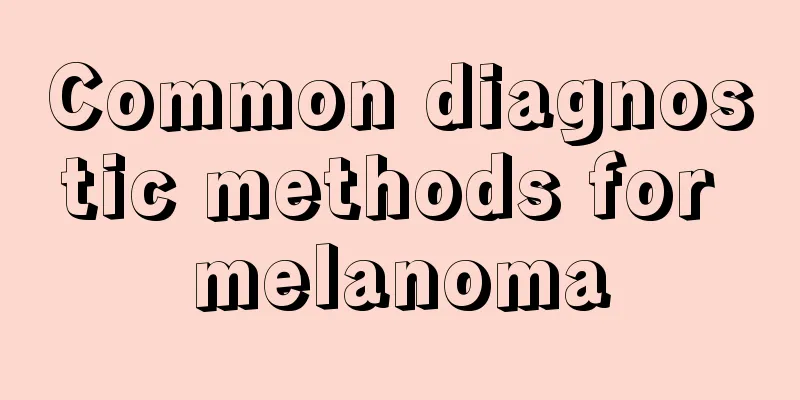What are the dietary considerations for patients with melasma?

|
Melasma is a common facial disease and a type of skin disease. This is mainly caused by long-term exposure to the sun. The population that generally suffers from the disease is mainly middle-aged women around 40 years old, and the disease progresses slowly, with seasonal changes. Therefore, patients with chloasma should be more particular about their diet than ordinary people. So what are the dietary precautions for patients with melasma? Chloasma has a great impact on women's facial skin, both in terms of appearance and harmfulness, so it needs to be treated in time to prevent the disease from becoming more and more serious. In terms of daily diet, you should be more careful about certain foods, as some foods may make the condition worse. So what are the dietary precautions for patients with melasma? Dietary considerations for patients with melasma Melasma, also known as liver spots, is a common acquired hyperpigmentation skin disease that occurs on the face. It occurs in sun-exposed areas and worsens after sun exposure. It is more common in young and middle-aged women. The course of the disease is chronic, with no obvious subjective symptoms. The disease has a certain seasonality, being more severe in summer and milder in winter. The average optical density of the pigment along the area is more than 20% greater than the average optical density of the face itself. Cause: More common in women, its onset is related to pregnancy, long-term oral contraceptives, and menstrual disorders. It is also seen in patients with some female reproductive system diseases, tuberculosis, cancer, chronic ethanol poisoning, liver disease, etc. Sunlight can precipitate the disease. However, many patients have no clear triggering factor. Clinical manifestations: It is more common in women, especially those during pregnancy, postpartum period and those taking oral contraceptives. The lesions are yellowish brown or dark brown patches, and the rash is symmetrically distributed on the face, forehead, cheeks, both sides of the nose, around the lips, and chin. They are finger-sized to coin-sized or palm-sized, irregularly shaped light brown or dark brown spots with distinct or blurred boundaries, which can merge into large patches. There are no subjective symptoms, the disease lasts for a long time and worsens after sun exposure. Some of them may slowly disappear after childbirth or discontinuation of contraceptive pills. No subjective symptoms or systemic discomfort. Chloasma is a facial disease characterized by the appearance of spots on the face. Many female patients suffer from this disease. So what should you do after you get it? In fact, dietary adjustments can reduce chloasma. Now I will introduce what chloasma patients need to pay attention to in their diet. First of all, patients with chloasma should reduce the consumption of staple foods such as black beans, walnuts, red water chestnuts, pork liver and other dark foods, which can easily reduce the content and concentration of melanin in the body and is also beneficial to the health of internal organs. Dark foods also include purple rice, red beans, green beans, black sesame seeds, black-bone chicken, beef and mutton, strong tea, cola, coffee and chocolate, soft-shelled turtle, dark-fleshed fish, sea cucumber and other meats. In addition, there are carrots, spinach, purple radishes, purple cabbage, shiitake mushrooms, black fungus, etc. These vegetables should also be consumed less. Secondly, patients with chloasma should eat less barbecued and fried foods. These foods are loved by many people. Although spicy stinky tofu and lamb skewers that smell spicy and delicious can satisfy your appetite, eating them can be very harmful to the treatment of pigmentation. Eating barbecued and fried foods not only makes you fat, but the oxides they contain will accelerate skin aging. Therefore, you should eat less of them. If you really can't help it, you might as well supplement some foods rich in vitamin E before eating to resist aging, such as pumpkin, rubber, spinach, carrots, whole wheat bread, peanuts, sesame, brown rice, etc. Try to avoid eating grilled or fried foods. Again, patients with melasma should reduce their intake of photosensitive vegetables. Because these vegetables can easily make the skin darker, because they are rich in metal elements such as copper, iron, zinc, these metal elements can directly or indirectly increase the amount and activity of substances such as tyrosine, tyrosinase and dopamine quinone related to melanin production. Eating more of these foods will make the skin more vulnerable to ultraviolet damage and darken or develop spots, so you should consume them in moderation. Sweet potatoes, potatoes, spinach, leeks, celery, coriander, white radish, beans, etc. These vegetables make it easier for skin prone to spots to develop. Generally speaking, most vegetables that emit volatile pungent and special smells are photosensitive vegetables. It is best for patients not to eat these vegetables. Finally, patients with chloasma should put photosensitive fruits on the blacklist, such as lemon, papaya, cucumber, citrus, etc. The simplest way to judge is that most fruits with shiny surfaces are photosensitive. After eating these photosensitive fruits and vegetables, you should avoid sun exposure. In the midsummer season, you should eat more vegetables and fruits that inhibit pigmentation and make your skin whiter, such as kiwi, strawberry, tomato, cabbage, cauliflower, etc. It can effectively alleviate the patient's condition. Through the above introduction, everyone should have known the dietary precautions for chloasma. I hope everyone can do a good job in the dietary care of chloasma and thoroughly understand chloasma. To treat chloasma, you should choose a regular and professional dermatology hospital to avoid delaying treatment of the disease and causing more serious consequences. After reading the above question about the dietary precautions for patients with melasma, I believe everyone has some knowledge and understanding. In fact, patients with chloasma should eat less fried foods, and also eat less foods with high melanin content: for example: chocolate, coffee, etc., and also avoid eating irritating foods, otherwise it will easily aggravate the condition. |
<<: How to eat breakfast, eat healthy and nutritious
>>: Symptoms of trace element deficiency, how to supplement trace elements from food
Recommend
Why is the transaminase normal but the bilirubin high?
When our body's transaminase is normal but bi...
Do you know the early symptoms of bone cancer?
In recent years, the early symptoms of bone cance...
What is a sigmoid colon polyp
People should be familiar with human diseases in ...
How long can breast milk be kept in the refrigerator
Breast milk is the best food for infants. In dail...
How to quickly get rid of foot odor
Foot odor is not a disease, but it is a very emba...
Why does the flesh turn white after being scalded?
In our daily lives, we come into contact with var...
Several gallbladder cancer care details to pay attention to in daily life
MicrosoftInternetExplorer402DocumentNotSpecified7...
What should I pay attention to when I first start running
Everyone knows that running is very good for phys...
What diseases can be detected by blood
Blood tests can detect a lot of diseases, especia...
Can I get an injection for rhinitis
Everyone should be aware of the harmfulness of rh...
What are the complications of cervical cancer
Cervical cancer is a malignant tumor in women. Th...
Taboos of eating blackcurrant
Black currant is a common fruit. It tastes sweet ...
How to distinguish peony from herbaceous peony
In our lives, many people like to plant some flow...
Symptoms and treatment of bowel sounds in ulcerative colitis
According to statistics, the number of people suf...
What is the best treatment for colon cancer
How to scientifically treat patients with colon c...









